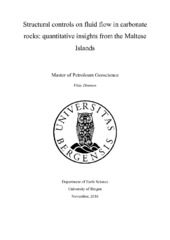| dc.description.abstract | This MSc thesis documents and quantifies the relationship between structural complexity and fluid flow through field based studies carried out in excellent outcrops along the coast of the Maltese Islands. There is a wide agreement in the literature today that faults and fractures exert strong controls on fluid flow and fluid-rock interactions in the shallow crust. Faults and fractures are known to act as conduits and/or barriers to fluid migration, in which locations of structural complexity such as relay zones and fault intersections, have been found to be particularly prone to act as loci for focused fluid flow. Such zones are found to contribute with higher fracture density, higher connectivity, and to a certain degree wider fracture apertures than less complex zones. This can influence a wide range of fluid types, including magma, hydrocarbons, and hydrothermal and mineralizing fluids. Structural complexity may therefore control a series of different processes in the Earth's crust and is an important field of study. Despite this wide recognition of structural control on fluid flow, there are currently no studies that systematically and directly quantify this relationship. This lack of documentation is where the motive for this study lies. To fill this gap, topological and geometric characterization of fracture systems in carbonate rocks has been conducted. Conjugant evidence of paleo-fluid flow in the form of diagenetically altered zones and localized cementation rates associated with the structures have been documented, and their varying extent are used to describe the amount of the fluid flow. The results show a direct relationship between the degree of structural complexity and evidence for paleo-fluid flow, as areas of increased cementation coincide with structurally complex zones, and the extent of redox fronts increases around zones of higher structural complexity. These findings have a wide range of application, and concerns both environmental, scientific and economic aspects through the implications structural complexity has on fluid flow concerning e.g. CO2 storage, ore deposition, hydrocarbon leakage, earthquake localization (by affecting pore fluid pressure), contamination of ground water, and more. | en_US |
